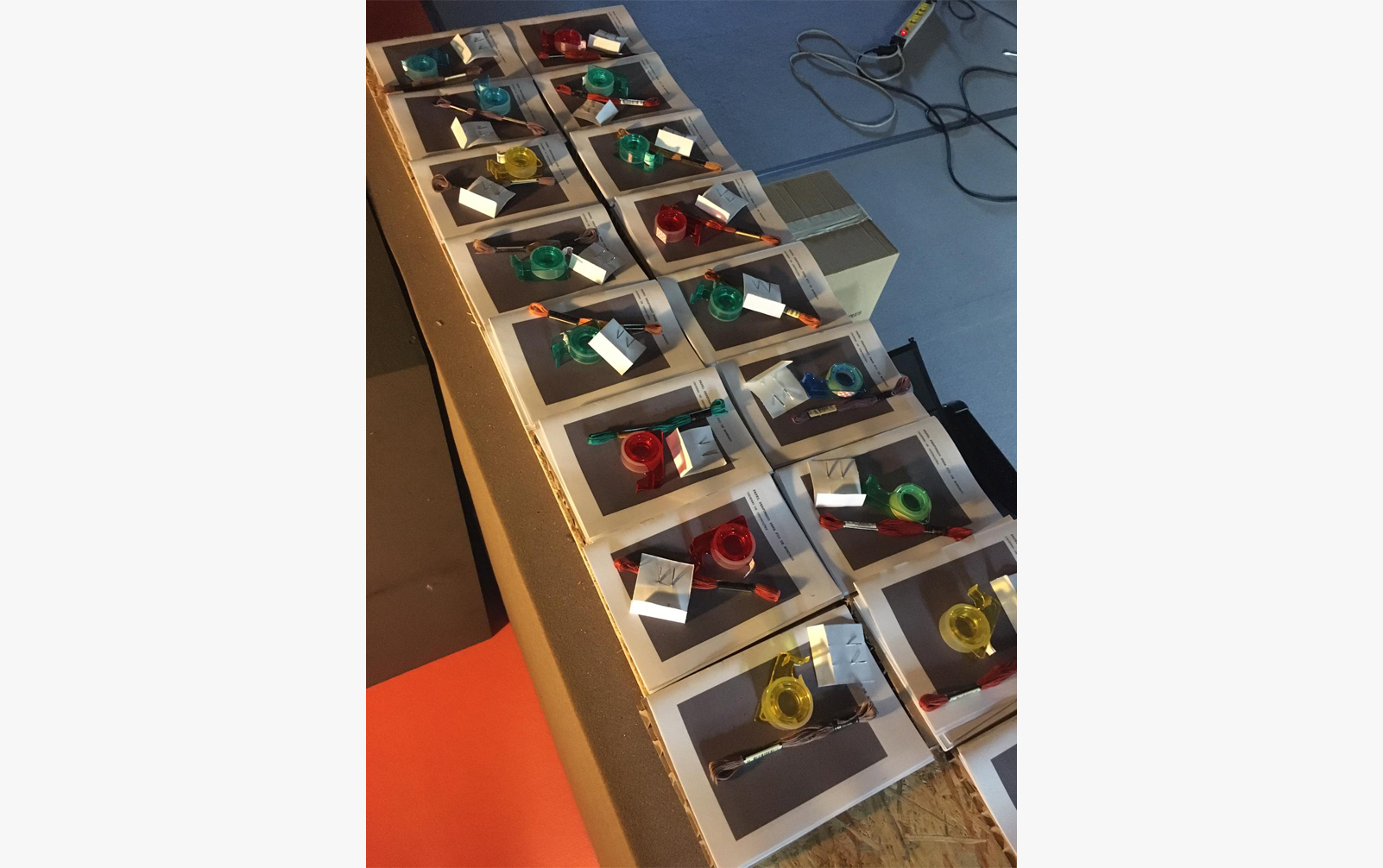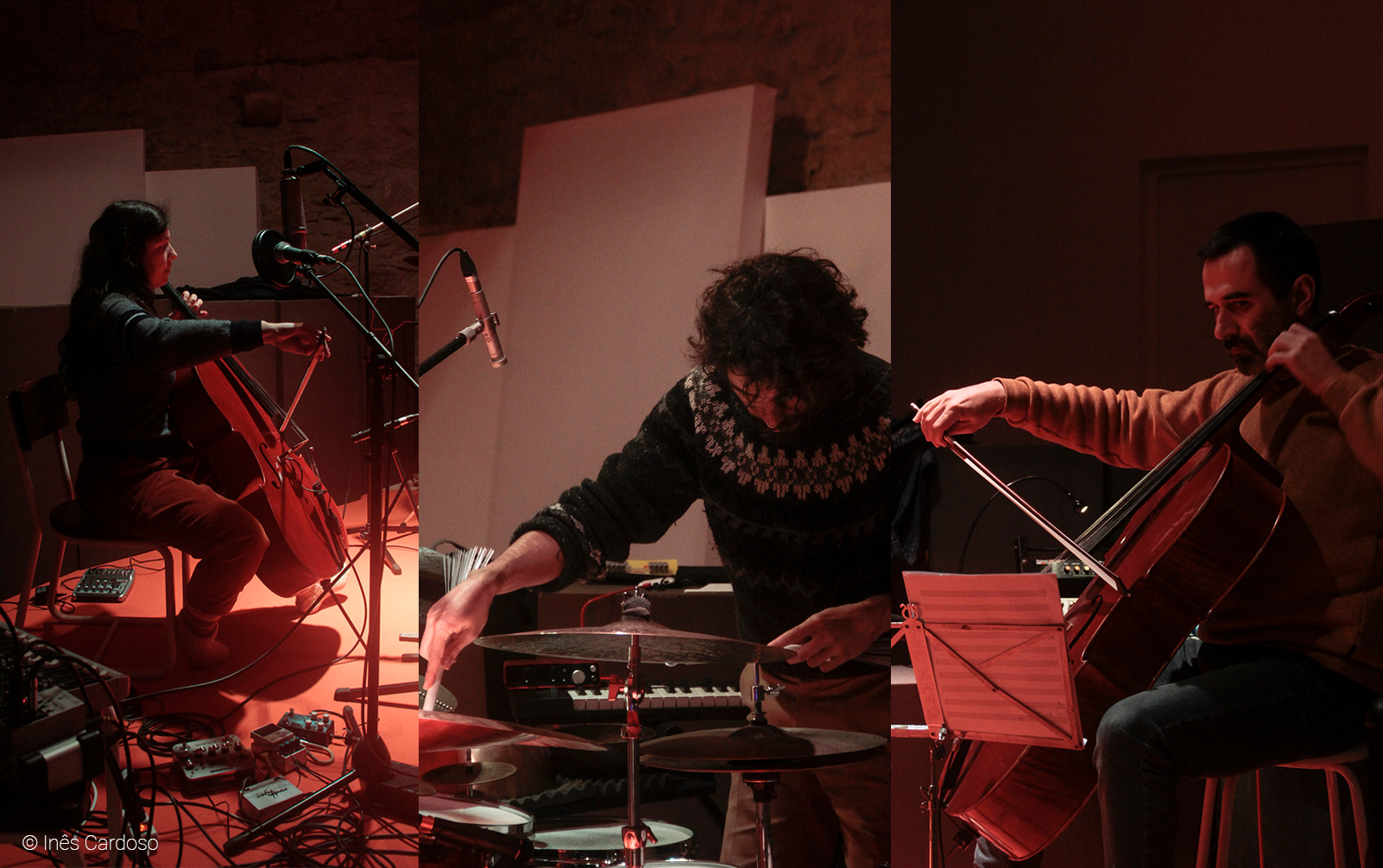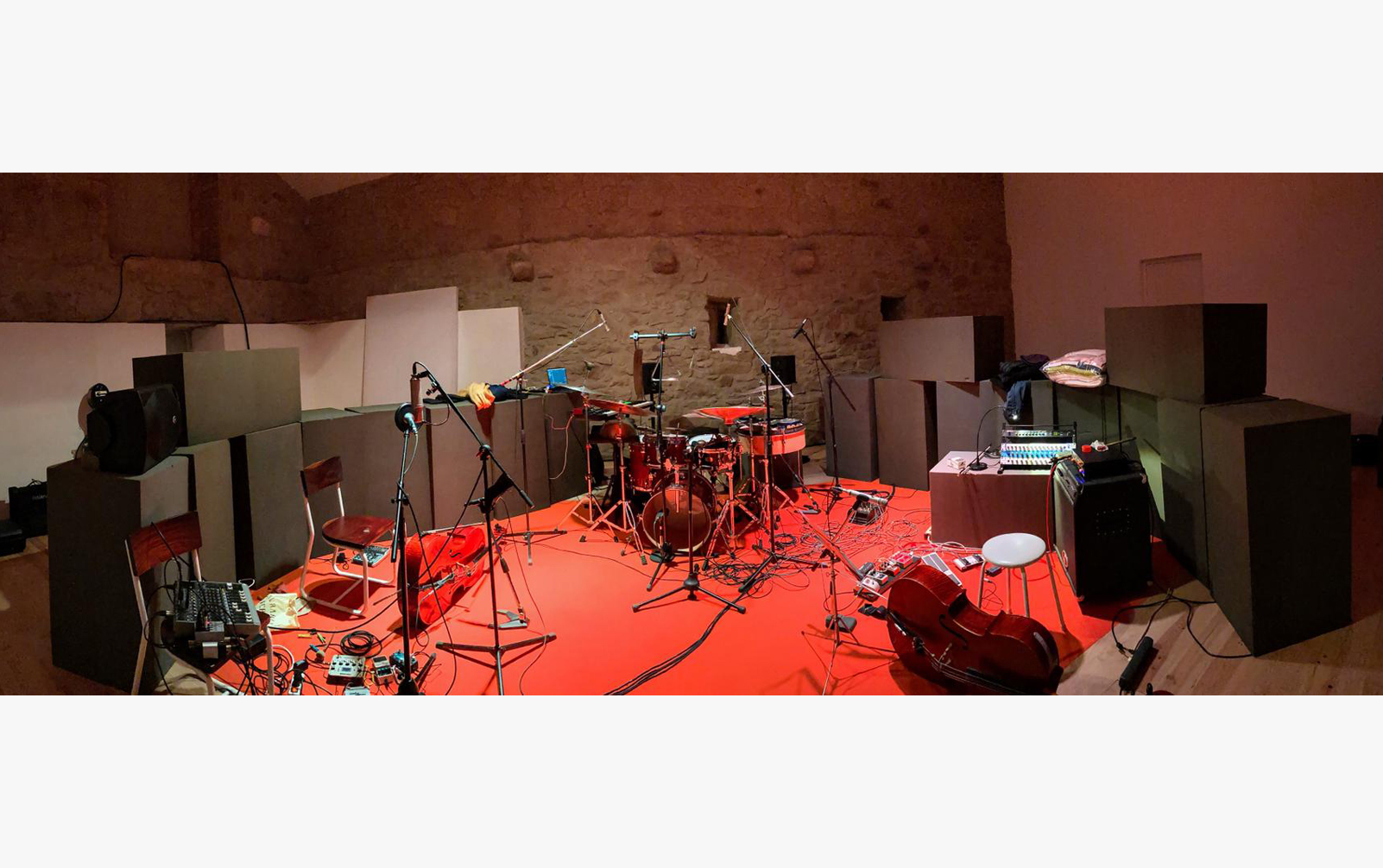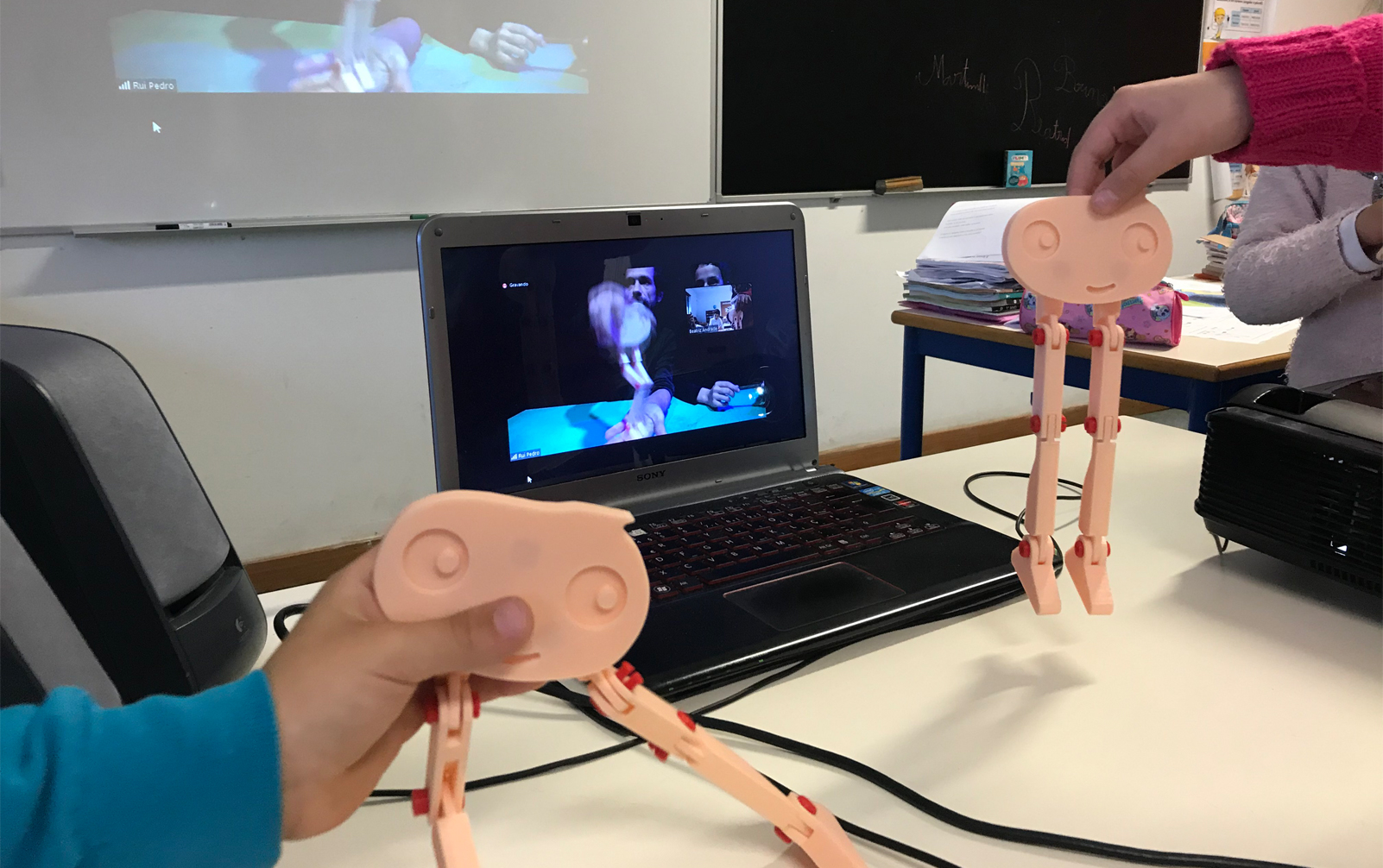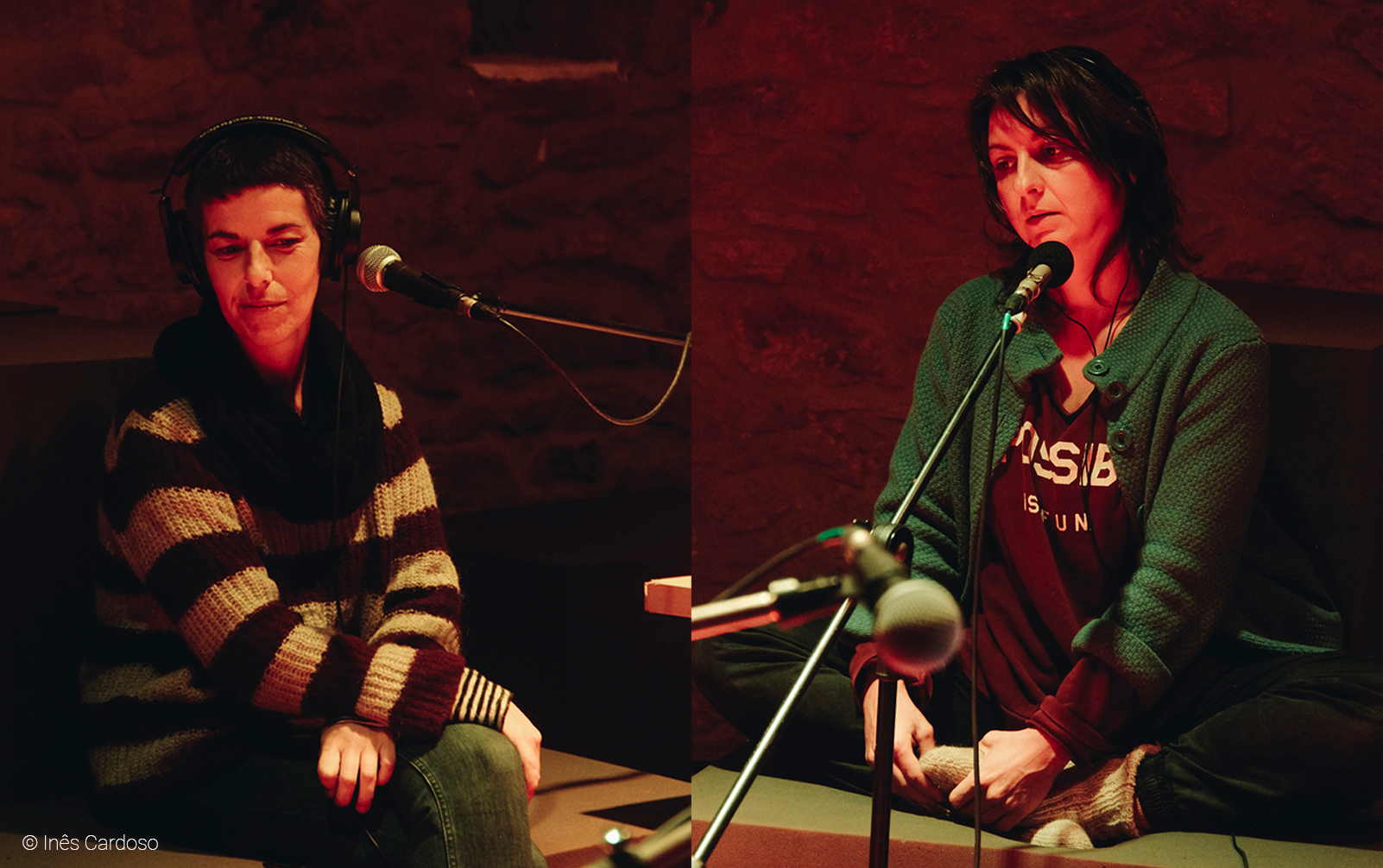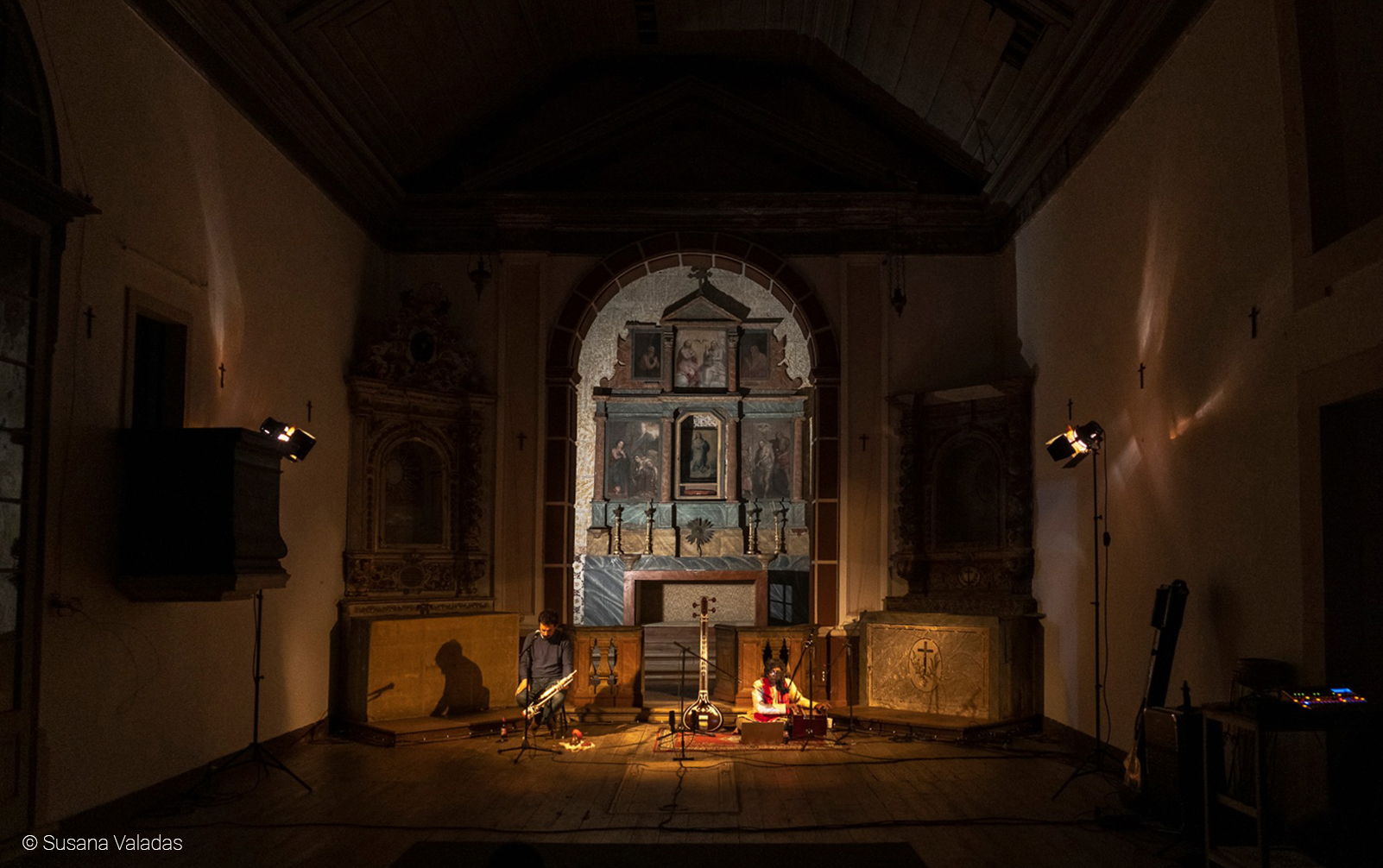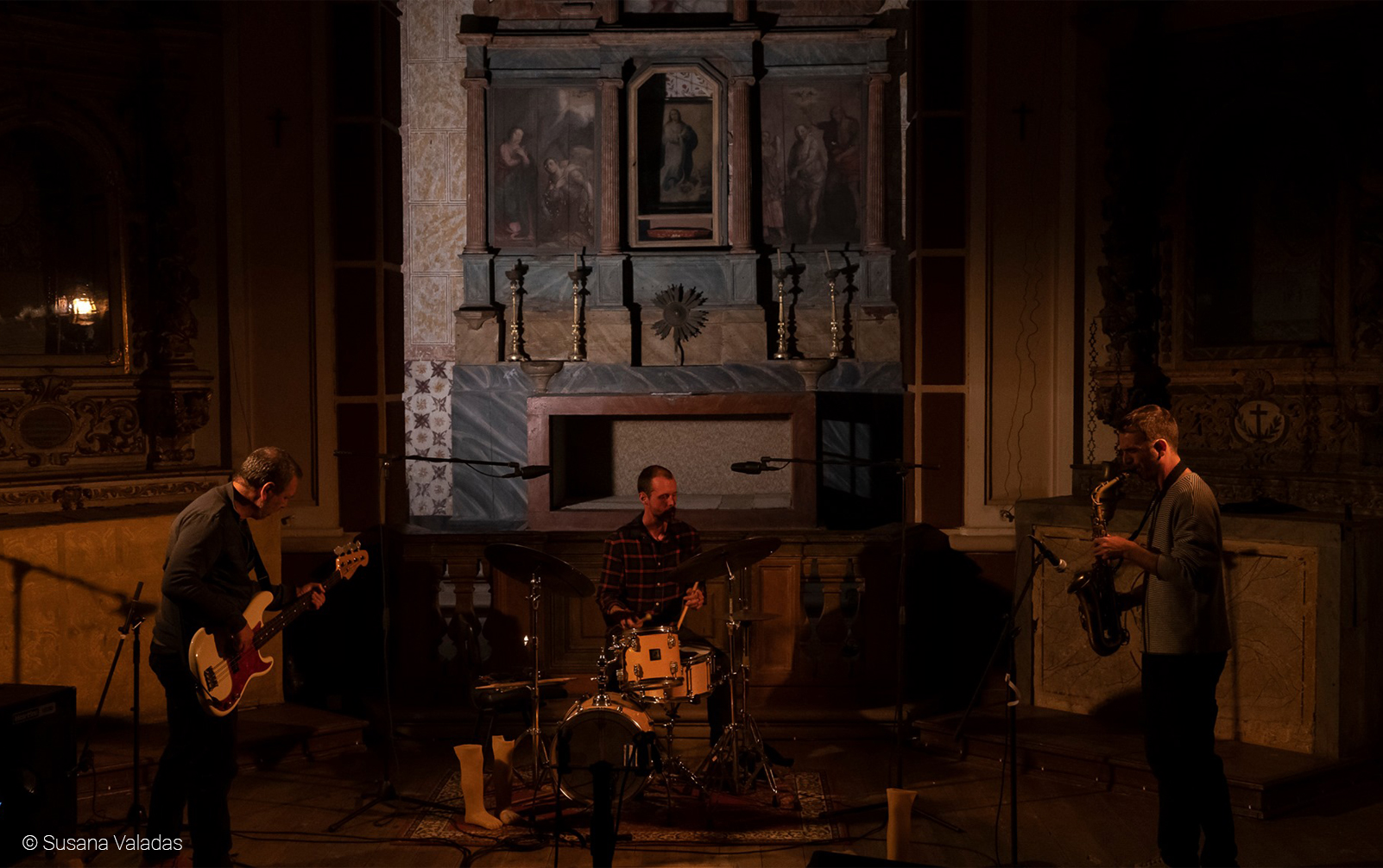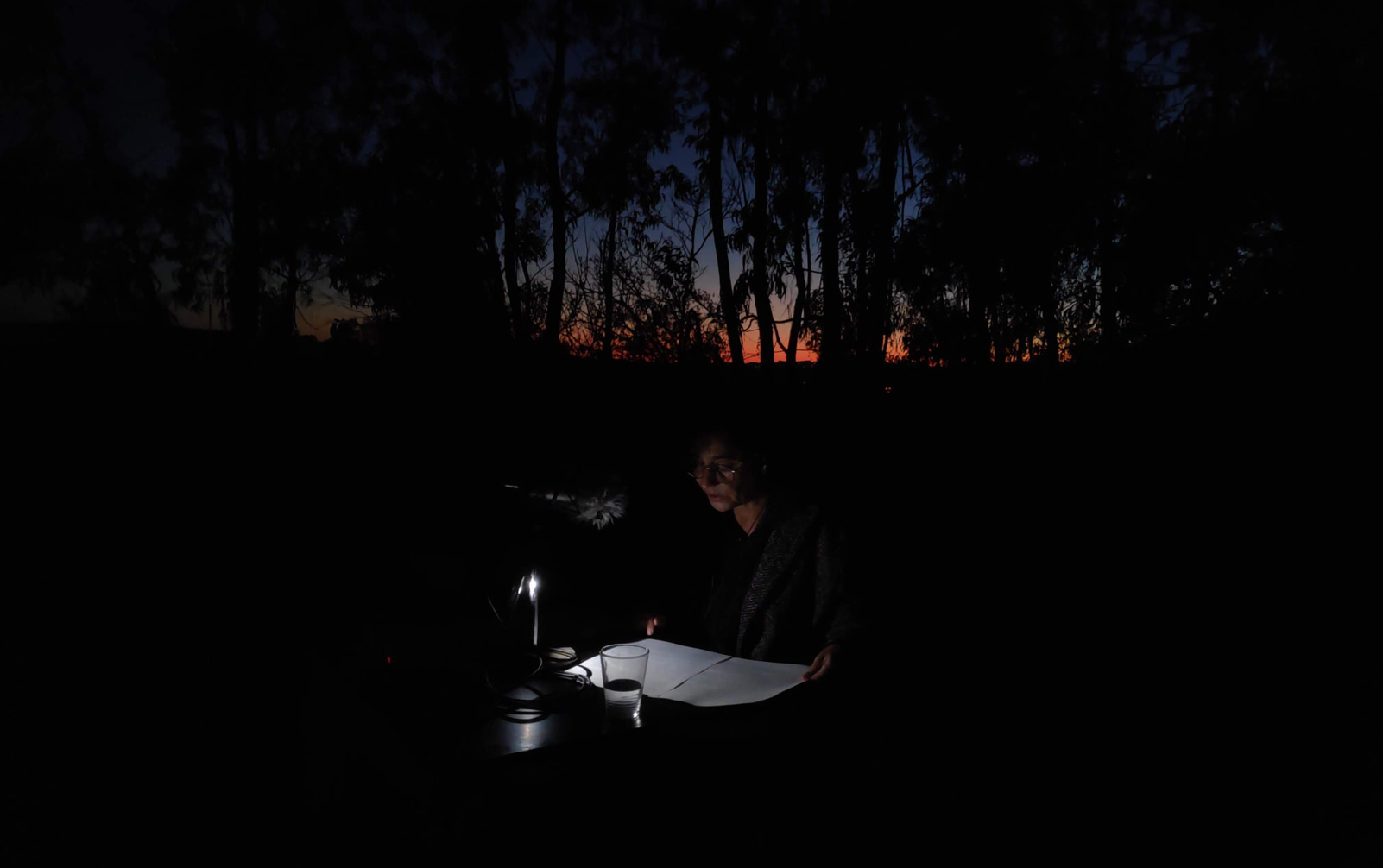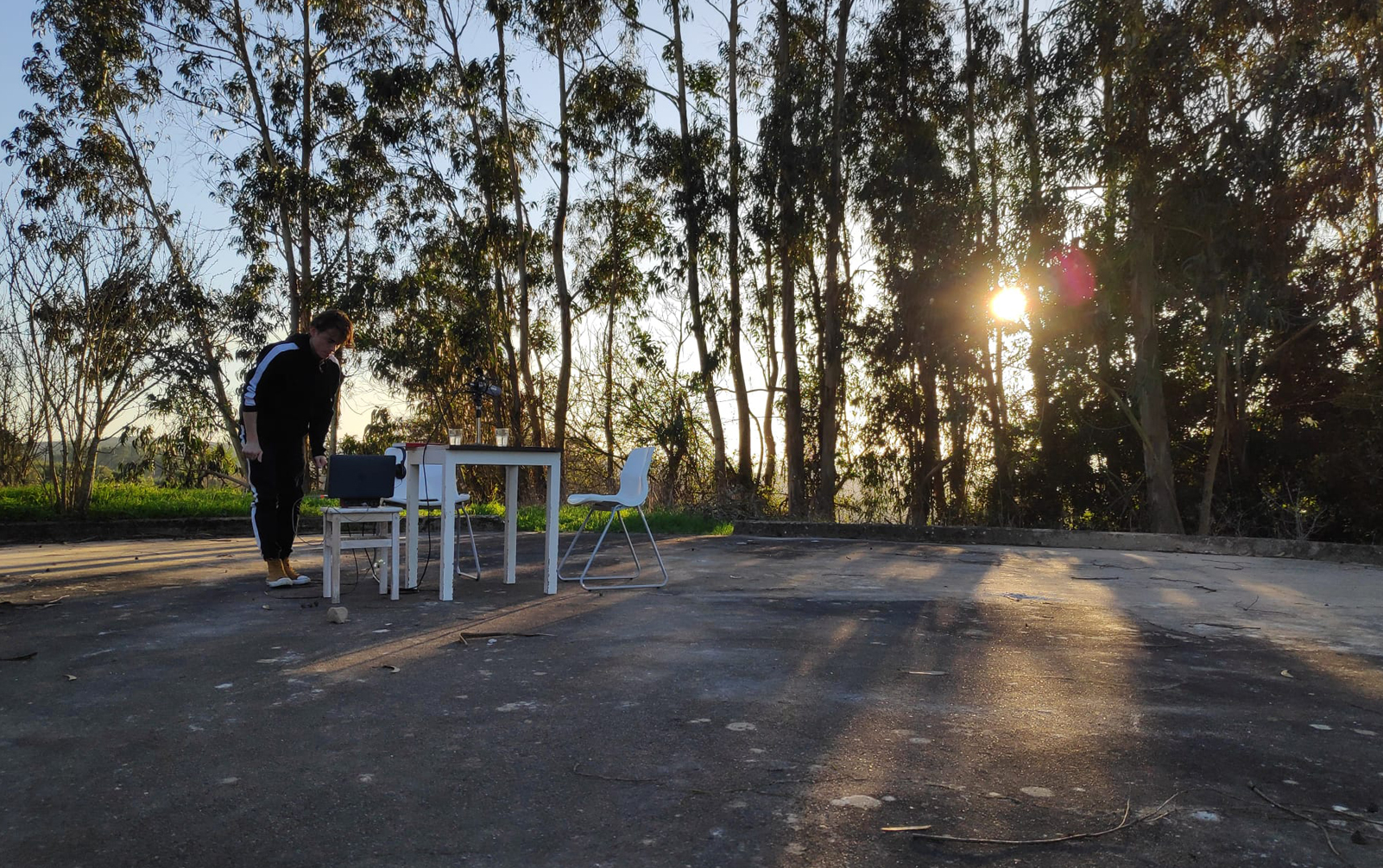Access the radio projects developed by artists, researchers and collectives invited to this third edition of EIRA. Also listen to their conversations with members of OSSO.
Sound Arts Students, Sound and Image Course – ESAD-CR IPLEIRIA
In the context of the Sound Arts class, 3rd year of the Sound and Image degree at ESAD in Caldas da Rainha, students were proposed to create a 6 minute sound piece for the Eira platform. In this course, students develop various works related to Sound Arts, such as listening exercises, sound walks, acousmatic compositions and sound installation projects. For this work, students were asked to think about a piece specifically for radio as a sound transmission device (FM and Online) with a programmed emission.
Afonso Correia
Alexandre Pereira
Almos Fekete
André Sá
Bruno Gama
Catarina Colaço
Gonçalo Maurício
Gonçalo Oliveira
Inês França
João Amélio
João Aranha
João Duarte
Leonardo Inverno
Licínio Santos
Márcio Pereira
Mariana Sendim
Matilde Fernandes
Miguel Bastos
Miguel Lança
Nuno Coelho
Pedro Coutinho
Ricardo Zambujo
Tomás Marreiros
“Atlantic Archive”
Atlantic Archive is a research project that proposes to think about coloniality through the elaboration of an archive – a set of texts, images, narratives and gestures that have the potential to inform and problematize the present.
Historically, the Atlantic Ocean has been a point of convergence between different places, universes and practices, intertwined by a common history of violence and colonisation, but also of exchange and invention. The Atlantic operates simultaneously as a political concept and a cultural territory, a space of crossings that inform and form multiple identities.
In this first cycle, the project takes the form of a literary essay, and narrates experiences located in between Portugal, Brazil and Angola, evoking the multiple ways in which the memory of the colonial process intersect and determines the present. Here, the Atlantic serves as starting point and conceptual framework for the invention of a speculative territory.
How to think the notion of territory beyond the logic of the nation-state or the fixed categories of belonging? How can we think about the material’s agency and the practices of identification beyond a binary understanding of the world? Or, following the lead of Denise Ferreira da Silva, how can we observe the difference and the singularity of archival materials without producing separability?
A research project by Beatriz Cantinho and Túlio Rosa, developed in the context of Osso Coletivo’s research residences, and has the support of Hosek Contemporary and Mala Voadora, and the collaboration of Talma Salem and Juan Valente.
The project is also part of the research developed by Túlio Rosa in the context of the postgraduate program a.pass {advanced performance and scenography studies}.
Beatriz Cantinho and Túlio Rosa (part 1)
Beatriz Cantinho and Túlio Rosa (part 2)
Beatriz Cantinho holds a PhD in Dance and Philosophy from the University of Edinburgh. Independent choreographer and researcher in the laboratories of CHAIA – University of Évora and CIAC – University of Algarve. In recent years, her work has been focused on a critical analysis of movement of aesthetic/political dimension, perceived as an expanded choreographic practice that supports her research and artistic creation.
Túlio Rosa is choreographer and researcher, part of the postgraduate research program a.pass {advanced performance and scenography studies}. His work focus on the relationship between the body and the field of images, as well as their status in relation to our political imagination.
Perforated paper for embroidery yarn
Bordados das Caldas are difficult to date but, given their designation (Bordados das Caldas da Rainha or da Rainha Dona Leonor, they are thought to go back to the time when queen Dona Leonor, D. João III’s wife, administrated her hospital. In her spare time, it is thought that, together with her maids, they performed beautiful embroidered works, with hypothetical Indian, Spanish or Venetian influences. It is said that queen Dona Leonor directed “Serões de Agulha”, where ladies from the region went to learn the arts of embroidery.
The perforated card was invented by Joseph-Marie Jacquard, in 1801, as an initial project of an automated “loom”. It is a card which, by the presence or absence of holes in predefined positions, represents information, being considered the precursor of computers’ memory.
These were the references used for the creation of the workshop, designed for IPSS users in São Gregório, that, due to the current restrictions and individual protection issues, will probably be held at home. For this reason, it was developed to be easy to perform, and with the purpose of being a relaxing exercise. With the paper that will be perforated and the embroidery thread, a harmonious card can be created, to be hung or to be offered to someone special.
Conversation between Nuno Torres and Ricardo Jacinto with Carla Castiajo | 02.12.2020
Carla Castiajo Carla Castiajo has a Degree in Art and Design, at the College of Art and Design in Matosinhos, Portugal, 2003. She holds a Master’s Degree in Fine Arts from the Konstfack, Stockholm, Sweden, 2006. A PhD from the Estonian Academy of Arts, Tallinn, Estonia, 2016. The subject of her artistic research was Purity or Promiscuity? Exploring Hair as a Raw Material in Jewellery and Art. She taught at different Universities in different countries, such as the Beaconhouse National University in Lahore, Pakistan, the Oakham School in Oakham, United Kingdom, the College of Art and Design in Matosinhos, Portugal, the Estonian Academy of Arts in Tallinn, Estonia, and the Academy of Fine Arts and Design in Bratislava, Slovakia. Her works have been presented in several exhibitions.
Carla Castiajo works within the fields of art and jewellery.
+ info: https://carlacastiajo.wordpress.com/
This project concerns performing György Ligeti’s (1923-2006) organ studies, Harmonies (1967) and Coulée (1969) by means of computer programming. It aims to simulate the reverberant space of a church and the sound of a pipe organ. These works use expanded techniques, unusual in this instrument. In this way the sound capacity of the instrument is expanded, which the public is unaware of.
It is understood that Ligeti’s ultimate goal would be to produce a new range of sounds. Ligeti invites the interpreter to be inventive and to seek solutions. In short, the proper interpretation of these organ studies requires artistic research, which can be recreated on a computer.
By using computer programming it is possible to relocate the reverberation of a church to another space, using several speakers. With the convolution of impulse responses it is possible to emulate the reverberation where these instruments usually reside. As far as the sound produced by the instrument, the technique of sampling of the aforementioned expanded techniques and their subsequent manipulation is used. In this way, the instrument and its acoustics are disassembled, making it possible to reassemble it elsewhere, exposing these works in places without reverberation and instrument. This approach has ramifications with acousmatic music. The computer recreation of these studies leads to an interconnection with the electronic pieces of Ligeti, Glissandi (1957) and Artikulation (1958).
Conversation between Matilde Meireles and Diogo Alvim with Cláudio de Pina
Cláudio de Pina, Organist, improviser and composer of contemporary music. Titular organist of the historical pipe organ of our Lady of Ajuda’s Parish. Researcher in GIMC/CESEM. Studied in Gregorian Institute of Lisbon, Hot Jazz Club and Physics Engineering in FCUL. Studied with Annette Vande Gorne, Gilles Gobeil, Trevor Wishart, Hans Tutschku, Jaime Reis, Åke Parmerud, Adrian Moore, Eurico Carrapatoso and César Viana. Master in Musical Arts. PhD candidate in Musical Arts regarding contemporary music for pipe organ and electroacoustic music (ESML/FCSH). His scientific output mainly concerns; musical analysis, musical composition, electroacoustic music, acoustic, sound synthesis, organ and musical performance. His work has been selected, edited and published worldwide.
Faculdade de Ciências Sociais e Humanas, Universidade de Lisboa (ESML/FCSH)
https://claudiodepina.weebly.com/
Fado Bicha will occupy an EIRA broadcast and try to create a sound representation of a possible queer reality in 21st century Portugal, mainly through music but also with poetry, stories and personal references and an interview with a guest.
Conversation between Nuno Torres and Ricardo Jacinto with Fado Bicha (Lila Esteves e João Caçador) | 03.12.2020
Fado Bicha’s live Broadcast | 11.02.2020
Fado Bicha is a musical and activist project created and developed by Lila Fadista, voice and lyrics, and João Caçador, instruments and arrangements. On stage, they operate an unprecedented exploration within the fado universe, overcoming the rigid gender barriers of traditional fado and creating narratives for themes that still had no expression. The project encompasses an intervention, starting with the representation of the LGBTI community, and adding issues that concern them and political positions in which they put themselves, talking about gender, colonialism, racism, feminism and animal rights, for example. What they bring is basically a subversion of the heteronormative rule, very strong in traditional fado, and in Portuguese society in general, claiming the right to appropriate a heritage that is also theirs and to exploit it according to their identities and experiences, which is at the base of any artistic process, whether it’s seen as subversive or not.
+ info: https://www.youtube.com/watch?v=OGEcDeg81zE
Essentially dedicated to cultural programming, Grémio sees in this residence the opportunity to create sound projects inspired by the work, collaborations and affinities it has developed up to now.
For the third edition of EIRA the collective will present a new program, with the transmission of concerts recorded for EIRA # 3, Simorgh (by João Lobo, with Norberto Lobo and Soet Kempeneer) and the free improvisation quintet with João Almeida, Álvaro Rosso, João Valinho, Marcelo Dos Reis and Albert Cirera, and live concerts of Chão Maior, Joana Guerra and Peter Gabriel Duo, included in the program of Lambda – Mostra de Ondas Sonoras e Visuais, with broadcasts from Igreja do Espírito Santo and Centro de Artes | Caldas da Rainha. The grid is completed with concerts recorded in previous editions of EIRA and other moments that are part of the Grémio archive.
Concert Simorgh, recorded on 28.10.2020, at Igreja do Espírito Santo, Caldas da Rainha
Concert João Almeida, Álvaro Rosso, João Valinho, Marcelo dos Reis e Albert Cirera, recorded on 14.11.2020, at Igreja do Espírito Santo, Caldas da Rainha
Concert Chão Maior, live broadcast on 16.11.2020, at Museu António Duarte, Caldas da Rainha
Concert Peter Gabriel Duo, live broadcast on 16.11.2020, on Igreja do Espírito Santo, Caldas da Rainha
Concert Joana Guerra, live broadcast on 16.11.2020, on Museu António Duarte, Caldas da Rainha
O Grémio Caldense is an informal group based in Caldas da Rainha, dedicated to the promotion of cultural events of an artistic nature. Operating since May 2015 and with a practically biweekly periodicity, until now, this group has organized about one hundred and fifty events of an essentially alternative nature, differentiated between concerts, independent edition fairs, cinema and poetry sessions, performances and visual arts exhibitions. With no fixed space for its activities, it operates in a variety of spaces in the city, from museums to reused public spaces, from the most conventional to the most improvised, with several partners with whom it has collaborated, public institutions, private entities and other associative groups.Due to the very balanced presence between national and foreign artists in its program, the group has placed Caldas da Rainha on an international circuit linked to contemporary and independent artistic culture.
Lantana is an improvisational/experimental music sextet, that unites several of the most creative improvisers of the portuguese scene of the last decade: Anna Piosik (trumpet), Helena Espvall (cello), Joana Guerra (cello), Maria do Mar (violin), Carla Santana (electronics), Maria Radich (voice). After the collective’s premiere at “MagaSessions” in Lisbon, they were invited by the singer Lula Pena to collaborate in an artistic residence at Galeria Zé dos Bois, this resulting in three concerts, between April and June of 2019. Thereafter they participated in Lisboa Soa Festival, Festival Jazz ao Centro at Coimbra, this last concert was nominated in the Best Show of the Year 2019 list of jazz.pt. This year they performed at the Festival Jazz 2020, at the outdoor amphitheater of Calouste Gulbenkian Foundation, and in the WarmUp of Indie Lisboa Festival.
At the moment they are preparing their debut album.
+ info: https://soundcloud.com/lantanamusica
Conversation between Nuno Morão, Nuno Torres and Ricardo Jacinto with Lantana (Anna Piosik, Helena Espvall, Joana Guerra, Maria do Mar, Carla Santana e Maria Radich) | 07.12.2020
Lantana’s live broadcast | 14.02.2020
From the Garden of Eden, in the passage through the Garden of the “delights” of Epicurus, in the course of the Garden of Gethsemane and in confrontation with the Garden of Afflictions, I find my garden.
They are small sketch’s from my experience of the sensitive, in which I put my voice in the rescue of my hand.
Conversation between Nuno Morão, Nuno Torres and Ricardo Jacinto with Martinha Maia | 07.12.2020
Conversation between Ricardo Jacinto and Benedita Pestana (O Armário) | 07.12.2020
I – Quando cantas para o horizonte
II – O musgo tacteia a tua pele
III – O teu corpo é de terra
IV – Sobrepões diferentes camadas
V – Sacode o pó
VI – Afasta com os dedos a erva
VII – Lentamente respiras a neblina
VIII – Aguardas que as nuvens se afastem
IX – Não te esqueças de respirar
X – Miosótis e rosas em seus canteiros
Martinha Maia, was born in São Mamede do Coronado in 1976.
Graduated in Fine Arts in 2000 at ESAD in Caldas da Rainha
He has been developing work since 2000, using performance, video, installation and drawing as the main means of expression.
He was part of numerous exhibitions, such as: 30 artists under 40, Stenersen Museum, Oslo, 2004; j´en rêve, Foundation Cartier pour l’art Contemporain, Paris, 2005; Sobre Barroco, Casa de Velázquez, Madrid, 2007; Muyethlek, Museu de Arte Maputo, Maputo, 2008; A “fluxus” thing 2, Exhibition and Performance Night in Fetish & Consumption, at Stuttgart Academy, in 2008; De sensu et sensato, Espaço Tranquilidade, 2012; 30 anos dos CAM, Ciclos de performance, CAM, Lisboa, 2013; Da fábrica que desvanece à baía do Tejo, Parque Empresarial Baía do Tejo (Quimiparque), Barreiro, 2014; Imaginarius, Centro de Artes e Cultura de Ponte de Sor, 2018; Poética do Obtuso, Quase Galeria, Porto, 2019; Coleópteros, Museu Nacional Soares dos Reis, Porto, 2019; Qualquer coisa contrária à natureza, Caos, Casa d’arte e ofícios, Viseu, 2019; Uma espécie de lugar, O Armário, Lisboa, 2020
Lives and works in Porto.
Preto Mate is the lathing on which you find two cellos, the electronic expansion of Ricardo Jacinto, the multi percussion of Pedro Melo Alves and the obscure chants of Joana Guerra. Strings and Percussion fused on an improvised music with echoes from the XX Century and a profoundly immersive nature.
Joana Guerra cello and vocals
Pedro Melo Alves drums and percussion
Ricardo Jacinto cello and electronics
Conversation between Nuno Morão and Preto Mate (Joana Guerra, Pedro Melo Alves e Ricardo Jacinto) | 11.12.2020
Preto Mate´s concert at Sonoscopia | 12.12.2020
Planet Plip
A little planet of sounds
A cookie planet at each day that goes by
A planet cake at the planet’s garden
ordered and disordered
Some hover by the legs, some by the heads
Workshop created after the play for children PLIP. Based on the creative process of the show, the participants will idealize and create their mobile and private planet, going through the steps inherent to artistic creation, of an open creative universe always in transformation. Participants will, over a period of days, be introduced to the planet Plip, which will serve as a motor and inspiration, through small challenges launched. At the end, each participant will have their Plip kit (pieces of a puppet similar to a character in the show), which will be assembled like a lego and animated under the guidance of the trainers.
Conversation between Nuno Torres and Ricardo Jacinto with Red Cloud Teatro de Marionetas (Sara Henriques e Rui Rodrigues | 03.12.2020
Rádio Plip
Rockinho
Red Cloud Teatro de Marionetas is a Portuguese company, based in Aveiro, founded in 2013. Participates in national and international Theater Festivals with and with Marionettes, presenting to children and adults.
Based on the motto Puppets in motion, it expands the concept of Puppet. Investigates and develops his contemporary language in the regular creation of shows and subsequent circulation. In a limbo between tradition and today, it also fulfills the mission of preserving, disseminating and circulating the popular Portuguese puppet tradition “Teatro Dom Roberto”.
Operates on 4 fundamental axes:
Experimentation, Creation and itinerancy of shows,
Development of your language in a contemporary context with a focus on the cinematic experience of the theater,
Preservation and dissemination of “Teatro Dom Roberto”,
Rescue and expansion of audiences through the artistic areas of the theatrical context in which it operates.
+ info: https://redcloudteatro.wixsite.com/red-cloud
Conversation between Nuno Morão, Nuno Torres and Ricardo Jacinto with Gustavo Costa | 07.12.2020
Coded time signals
Invisible communication systems, digital smoke signals and codes of ethics from experimental communities emitted from Sonoscopy.
Gustavo Costa, laptop
Jan Solcani, laptop
João Ricardo, laptop
Sonoscopia´s live broadcast | 06.12.2020
Som Desorganizado
Som Desorganizado is an annual meeting promoted by Sonoscopia and which seeks to aggregate ideas from innovative sound explorers. It focuses on the presentation and discussion of artistic works, creative collectives and new musical directions. From a more comprehensive perspective, Som Desorganizado is also a reflection on the very meaning of sound, and on how it can be organized into musical artifacts.
Sonoscopia´s live broadcast | 12.12.2020
Sonoscopia is an association for the creation, production and promotion of artistic and educational projects primarily focused in the areas of experimental music and sound research.
+ info: www.sonoscopia.pt
Two notebooks: fragments and exercises
The research residency focuses on the intersection between my interdisciplinary artistic practice and teaching practice in higher education (ESAD.CR). During the residency I intend to start working on two notebooks; the fragment notebook, which consists of summarized quotations, but which are dispersed. And the exercise book, where I intend to gather movement exercises, micro poetic actions, which I practice and make available to my students, indoor and outdoor. The residency is the opportunity to mark a moment of my a/r/tographic research; to develop and apply artistic-pedagogical methods that arise from the relationships between my artistic practice and the student’s artistic practice in the discovery of performance, based on live performance, destined to find a visual, sound or spatial transcription, or linked to the creative process.
Conversation between Matilde Meireles and Diogo Alvim with Teresa Luzio
Teresa Luzio (*1976) Artist books, analog videos and photographs are traces of her performances, defined by no public attending, or their presence is by chance. Her work arises from what she observes, whether it is a place, an object, or a situation, to disturb its configuration, to go through it as a way of perceiving things. Teresa graduated between Portugal and Germany. She has a Masters in public art and new artistic strategies (Weimar) and a PhD in performance (FBA.UP). She has been a professor at ESAD.CR since 2008.
In her book The Posthuman, Rosi Braidotti asserts that humanism ‘implies the dialectics of self and other’, so that ‘sexualised, racialized, and naturalised others’ are ‘reduced to the less than human status of disposable bodies’ (2013). A posthuman philosophy breaks free from this humanist model, in which ‘he’ is at the centre of bodily, mental, discursive and spiritual values. The Entanglement (2020) is an audio work that describes a breakdown of bodily boundaries between human and nonhuman. In a disused quarry, where a matriarchal moss colony thrives out of the absence left behind by extraction, the artist is reclaimed by the moss and subsumed by the ancient rock below. This work positions Braidotti’s posthuman as a frame that offers the potential to destabilise the cultural constructs of identity, whilst providing an opportunity for playful transformation in place.
Conversation between Matilde Meireles and Diogo Alvim with Victoria Lucas
Victoria Lucas (b.1982, UK) is an artist, practice-led PhD candidate at SHU and Senior Lecturer in Fine Art at UCLan. She is currently artist-in-residence at Site Gallery and a member of the YSI Sculpture Network 2020. Victoria’s practice incorporates sculptural forms with video, photography, sound and performance. She uses technology to remap, embody and entangle material strata, a process in which female subjectivity is reimagined in place.
Sheffield Hallam University, England (SHU)
www.victorialucas.co.uk
The main topic of this artistic-research PhD project is the landscape as an artistic genre as well as a geographical issue. Landscape is understood from a perspective that prioritizes the experience of spaces from within and from below, instead of from outside and from afar. The project takes as reference non western ways of doing cartographyes and images of spaces that involves valuing haptics over optics, proximity over distance, transformation over representation, flow, fragment and singular findings over a totalizing image.
The methodology involves the realization of a series of actions or tactics, collecting of objects, matter and information as they are found in spaces. This involve a spatial and temporal experiences in which body, close perception, memory, random and finding become allies. These actions are determined by chance.
Conversation between Matilde Meireles and Diogo Alvim with Viviana González Mendez
Viviana González Méndez is a Colombian artist with studies in fine arts and aesthetics and art theory. As an artist she has had exhibitions in countries such as Switzerland, Bolivia, Germany and Colombia. Her work focuses on issues such as urban and rural spaces and experimental cartographies mainly through installations. Currently she is a PhD candidate of the programme Fine Arts/Cultural theory of Zurich University of Fine Arts (CH)/University of Art and Design Linz (AT)
Zurich University of Fine Arts (CH)/University of Art and Design Linz (AT)
http://cargocollective.com/vivianagonzalezm



